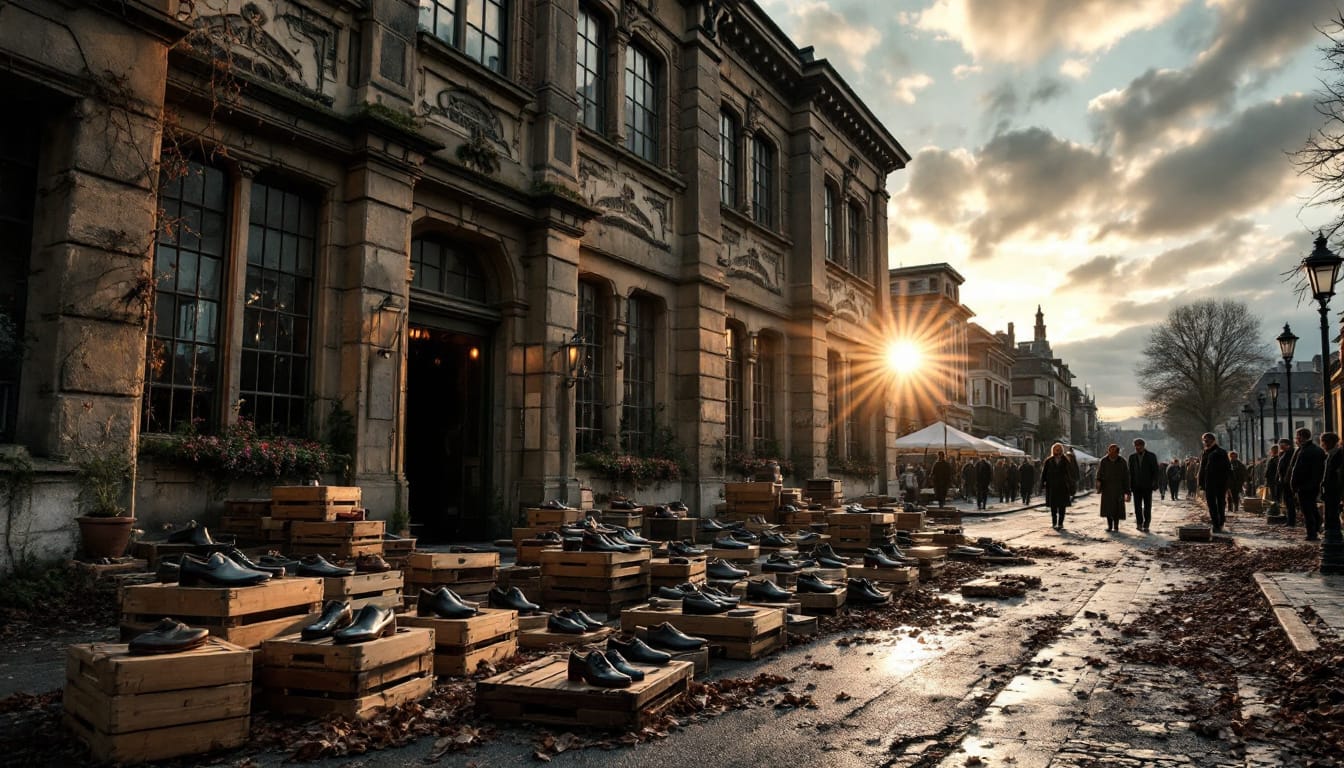In today’s digital universe, interactions on websites are increasingly scrutinized.Automated systems often detect suspicious behaviors.This surveillance aims to protect both users and platforms.
When your online activity is perceived as that of a robot, it can lead to unexpected interruptions. If you are using an anonymous proxy, it is recommended to disable it and try again. If the error persists, contacting the customer service with the appropriate incident number may help resolve the issue. In the meantime, you have the option to continue browsing by confirming your identity via the “I am human” box. These measures ensure a smooth user experience while maintaining the security of systems. Adopting such solutions is essential in the context of digital transformation and the optimization of industrial processes.

Table des matières
ToggleThe liquidation of Clergerie marks the end of an era for Romans-sur-Isère
The city of Romans-sur-Isère is going through a transition period with the liquidation of Clergerie, its last major manufacturer of luxury shoes. This decision marks not only the end of an iconic company but also a significant turning point for the local economy and the industrial identity of the region.
What are the reasons behind the liquidation of Clergerie?
The liquidation of Clergerie results from several economic and strategic factors. Faced with increased competition in the global luxury shoe market, the company encountered difficulties in maintaining its profitability. The rapid evolution of consumer trends and rising production costs also played a decisive role. Moreover, the lack of an effective adaptation strategy in the face of new digitalization technologies limited Clergerie’s ability to innovate and remain competitive.
According to internal sources, human resource management has also been a major challenge. The difficulty in attracting new talent and retaining key employees has contributed to declining productivity. Additionally, the company failed to sufficiently diversify its offerings to meet changing market demands, leading to a gradual decrease in its market share.
This situation is not unique to Clergerie. Other companies in the cloud technology and cyber-physical systems sectors have also felt the pressures of the globalized market. To learn more about the challenges faced by European companies in the technology sector, check out this article.
What impact will this liquidation have on the local economy of Romans-sur-Isère?
The announcement of Clergerie’s liquidation has immediate repercussions on the economy of Romans-sur-Isère. As the last major manufacturer of luxury shoes in the region, its closure results in the loss of numerous jobs and directly affects the purchasing power of the residents. Local suppliers and partner businesses will also see a decline in their activities, which could lead to chain closures.
Local authorities are already working on economic recovery strategies to compensate for this impact. Initiatives aimed at attracting new companies and supporting local startups are underway. Furthermore, the regional government is considering training programs to help former Clergerie employees transition to other promising sectors.
A positive example is the recent takeover of the factory by the employees of the SCOP La Meusienne, marking a new era of autonomy for 40 employees. This initiative shows that innovative solutions can emerge in the face of economic challenges. For more details on similar initiatives, check out this article.
How are former Clergerie employees being supported in this transition?
The closure of Clergerie necessitates rigorous support for the affected employees. Support measures, such as severance pay, professional training programs, and placement services, are being implemented to facilitate the transition of former employees to new job opportunities. Local unions are closely collaborating with authorities to ensure that workers’ rights are respected and that support is tailored to their needs.
Additionally, private initiatives and partnerships with local technology companies are being considered to offer job opportunities in growing sectors. The rise of cloud technologies and cyber-physical systems in the industry offers new avenues for the skills acquired by Clergerie employees. Retraining in these fields could not only benefit the workers but also contribute to the industrial renaissance of Romans-sur-Isère.
It is also planned to create coworking spaces and business incubators to encourage innovation and local entrepreneurship. These spaces will provide the necessary resources for former employees to develop their own projects or join dynamic startups. To learn more about support initiatives for transitioning employees, check out this article.
What are the local community’s reactions to this closure?
The liquidation of Clergerie has caused shockwaves within the community of Romans-sur-Isère. Residents, proud of their industrial heritage, feel a deep loss of their local identity. Community events, traditions associated with the company, and relationships between employees have created a strong bond between Clergerie and the city.
Reactions are mixed between sadness and hope. While some fear an economic decline, others see this liquidation as an opportunity for renewal and industrial diversification. Local committees are forming to organize meetings, discuss issues, and propose innovative solutions to revitalize the region.
Cultural initiatives and projects for repurposing the former Clergerie premises are being developed. These projects aim to transform industrial spaces into cultural centers, coworking spaces, or technology business incubators. This transformation could attract new investments and energize the local economy while preserving the industrial heritage of Romans-sur-Isère.
What are the future prospects for the luxury shoe sector in Romans-sur-Isère?
The end of Clergerie does not necessarily mean the disappearance of the luxury shoe sector in Romans-sur-Isère. On the contrary, this liquidation could open the door to new opportunities and a reinvention of the sector. Local artisans, leveraging their traditional know-how, may turn to more sustainable and innovative production models.
The integration of cloud technologies and cyber-physical systems into the manufacturing process could modernize techniques while preserving the authenticity of the products. The digitization of sales and the development of online platforms could also expand the reach of local brands to a global market.
Furthermore, the rise of the circular economy and ethical fashion presents new prospects for the sector. Consumers are increasingly sensitive to the environmental impact of their purchases, prompting manufacturers to adopt more sustainable practices. Romans-sur-Isère could position itself as a key player in this transition by combining tradition and innovation.
Finally, partnerships with educational institutions and research centers could stimulate innovation and the creation of new businesses in the sector. The local university could play a central role by offering training programs tailored to market needs and encouraging research and development in technologies applied to luxury shoe manufacturing.
How does the liquidation of Clergerie influence the image of Romans-sur-Isère?
The image of Romans-sur-Isère as a center for luxury shoe production is profoundly impacted by the liquidation of Clergerie. This closure represents the end of an era where the city was recognized for its artisanal know-how and its significant contribution to the fashion industry. However, this situation also offers an opportunity to redefine and revitalize the city’s image.
Efforts to transform former industrial sites into innovative and cultural spaces may help reposition Romans-sur-Isère as a dynamic and future-oriented city. By focusing on digital transformation and the integration of new technologies, the city can attract new businesses and investors, thereby enhancing its appeal and competitiveness.
Moreover, the promotion of industrial and artisanal heritage can be a source of pride and renewed identity for residents. Cultural events, exhibitions, and community initiatives can help preserve the memory of Clergerie while celebrating the new stages of the city’s development.
The commitment of the local community and economic actors in rebuilding the city’s image is crucial. By adopting a collaborative and innovative approach, Romans-sur-Isère can not only overcome the challenges posed by the liquidation of Clergerie but also position itself as a model of resilience and industrial reinvention.
What lessons can be learned from the liquidation of Clergerie for other industries?
The liquidation of Clergerie offers valuable lessons for other industries facing similar challenges. First, the importance of adaptability to market changes cannot be underestimated. Companies must be ready to innovate and integrate new technologies to remain competitive.
Next, effective human resource management is essential to maintain employee productivity and motivation. Investing in continuous training and creating an attractive work environment can help retain talent and encourage innovation.
Moreover, diversifying offerings and the ability to anticipate consumer trends are crucial to avoid decline. Companies need to be proactive in identifying growth opportunities and adapting their business strategies.
Finally, collaboration with local stakeholders, educational institutions, and research centers can stimulate innovation and foster synergies beneficial to the entire industrial ecosystem. The liquidation of Clergerie shows that without a global and integrated strategy, even established companies can encounter insurmountable difficulties.
By applying these lessons, other industries can better prepare for future challenges and ensure their sustainability in a constantly evolving economic environment.




